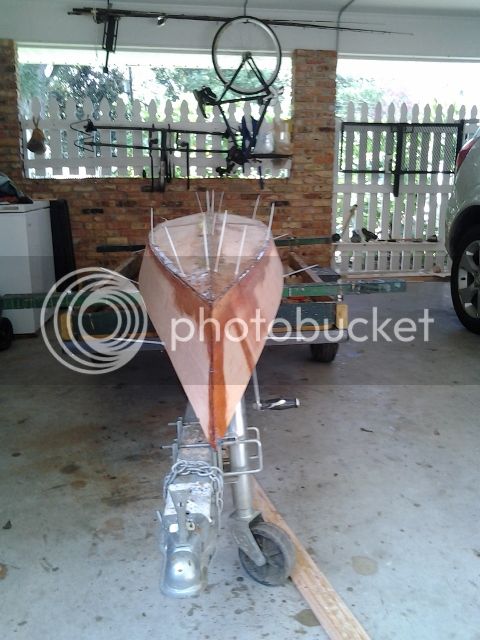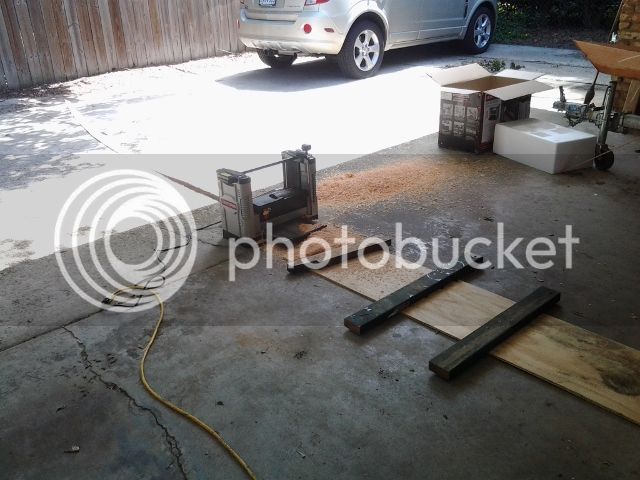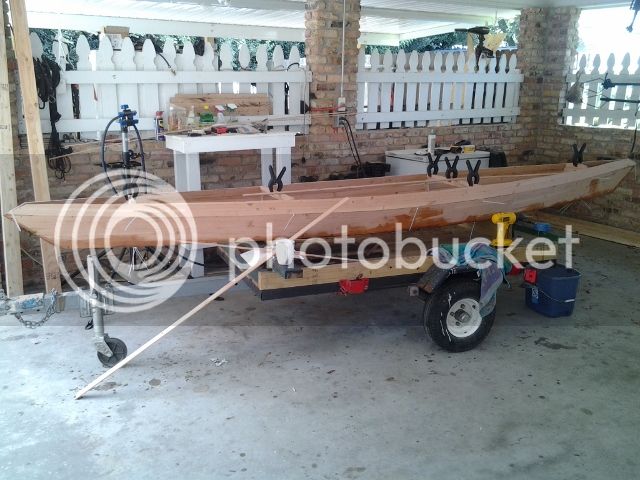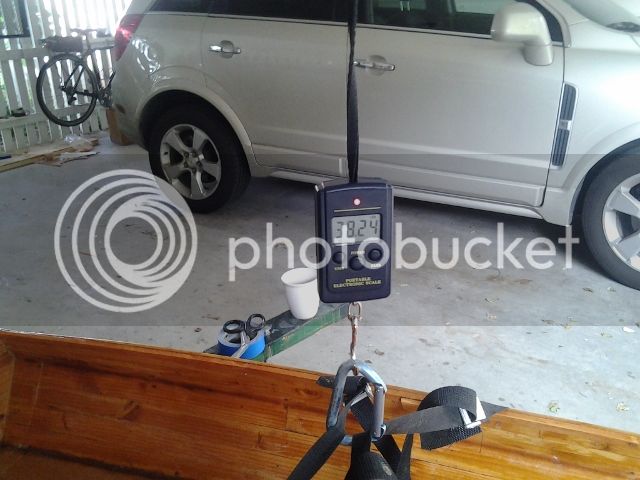I have done a bunch of straight and curved panels so I am going to go through it step by step.
This may get long.
Cutting strips
if you are using a board with rough edges before you start cutting strips run it through the planer on each side just for a clean up ,it will help you on the gluing of the strips.
I cut my strips thicker than I want for the finished strip and then plane both sides to so that i finish with a 1/16 thicker strip than i want in my finished panels,
Panel Layout
i build a table longer than my finished boats, put a straight strip down one side to use as my guide to measure from. I then lay my panel out and mark it on the table,then cover with saran wrap. For an example lets do a laker , I will layout from the center line of the plans (bottom middle) and that goes next to my line up strip ,I will lay enough strips to give me cutting room on the ends and outside edge I use a brad nail gun and cut strips when I nail them across the panel until it dries ,this makes it very easy to remove the brads. After doing both panels for the bottom I set them aside to dry after the saran wrap is removed
Then I go on to the side panels doing the same thing and then on to the tumble holmes.
I use a 13 inch ryobi planer , here is a little trick that will keep you from cutting a divot where you stop and start planing. Purchase a straight 1 by 12 8 ft long . open your planer and lay it on the bed 4 ft on each side then just proceed as normal ,it will keep your panels and strips flat. I always start out with the panel shoved to the top part of the curve, that lets you plane as much as you can before the panel comes into contact with your guide post, the guide post will take care of the feeding through the planer.
I always run my panel through glue side up till I get a smooth surface on that side then flip it over and do the other side till you hit your finish dimension.
Cedar is soft so use several small cuts instead of a heavy cut with the planer
I have used tight bond II and III I prefer the II and it seems to leave a clear finish where the III is dark
Cove and bead is not for me , I gave my bits away , it seemed to be a ton of trouble and no benefit ( my findings and yours may vary )
I dont use a scrapper on my panels ,the planer will clean them up with no problem
Run one side of all panels then adjust and run all panels again ,etc till you reach the thickness you want, this will help keep everything to the correct dimensions and make your edge fit up much easier.
I dont glass or coat my panels ,I do the whole boat at once
In my area marine plywood is 80.00 a sheet a four sheet boat 320.00 dollars
Material for strips is about 60.00 You can pay for your planer on the first boat you use strips instead of marine ply.
In my opinion ss@g glue can be built lighter,stronger and more durable than ply boats.
A little background , the first ss@g boat I ever saw was a perow Chuck built ,he used strips to make flat panels (strip sheets ,with straight strips) I looked at his method and came up with the curved panels and using the planer this let you carry the design and grain with the outline of the boat.
This is the only way I build now ,and I get questions from all over the world as they try this method.
Ron
I hope this helps
This may get long.
Cutting strips
if you are using a board with rough edges before you start cutting strips run it through the planer on each side just for a clean up ,it will help you on the gluing of the strips.
I cut my strips thicker than I want for the finished strip and then plane both sides to so that i finish with a 1/16 thicker strip than i want in my finished panels,
Panel Layout
i build a table longer than my finished boats, put a straight strip down one side to use as my guide to measure from. I then lay my panel out and mark it on the table,then cover with saran wrap. For an example lets do a laker , I will layout from the center line of the plans (bottom middle) and that goes next to my line up strip ,I will lay enough strips to give me cutting room on the ends and outside edge I use a brad nail gun and cut strips when I nail them across the panel until it dries ,this makes it very easy to remove the brads. After doing both panels for the bottom I set them aside to dry after the saran wrap is removed
Then I go on to the side panels doing the same thing and then on to the tumble holmes.
I use a 13 inch ryobi planer , here is a little trick that will keep you from cutting a divot where you stop and start planing. Purchase a straight 1 by 12 8 ft long . open your planer and lay it on the bed 4 ft on each side then just proceed as normal ,it will keep your panels and strips flat. I always start out with the panel shoved to the top part of the curve, that lets you plane as much as you can before the panel comes into contact with your guide post, the guide post will take care of the feeding through the planer.
I always run my panel through glue side up till I get a smooth surface on that side then flip it over and do the other side till you hit your finish dimension.
Cedar is soft so use several small cuts instead of a heavy cut with the planer
I have used tight bond II and III I prefer the II and it seems to leave a clear finish where the III is dark
Cove and bead is not for me , I gave my bits away , it seemed to be a ton of trouble and no benefit ( my findings and yours may vary )
I dont use a scrapper on my panels ,the planer will clean them up with no problem
Run one side of all panels then adjust and run all panels again ,etc till you reach the thickness you want, this will help keep everything to the correct dimensions and make your edge fit up much easier.
I dont glass or coat my panels ,I do the whole boat at once
In my area marine plywood is 80.00 a sheet a four sheet boat 320.00 dollars
Material for strips is about 60.00 You can pay for your planer on the first boat you use strips instead of marine ply.
In my opinion ss@g glue can be built lighter,stronger and more durable than ply boats.
A little background , the first ss@g boat I ever saw was a perow Chuck built ,he used strips to make flat panels (strip sheets ,with straight strips) I looked at his method and came up with the curved panels and using the planer this let you carry the design and grain with the outline of the boat.
This is the only way I build now ,and I get questions from all over the world as they try this method.
Ron
I hope this helps





